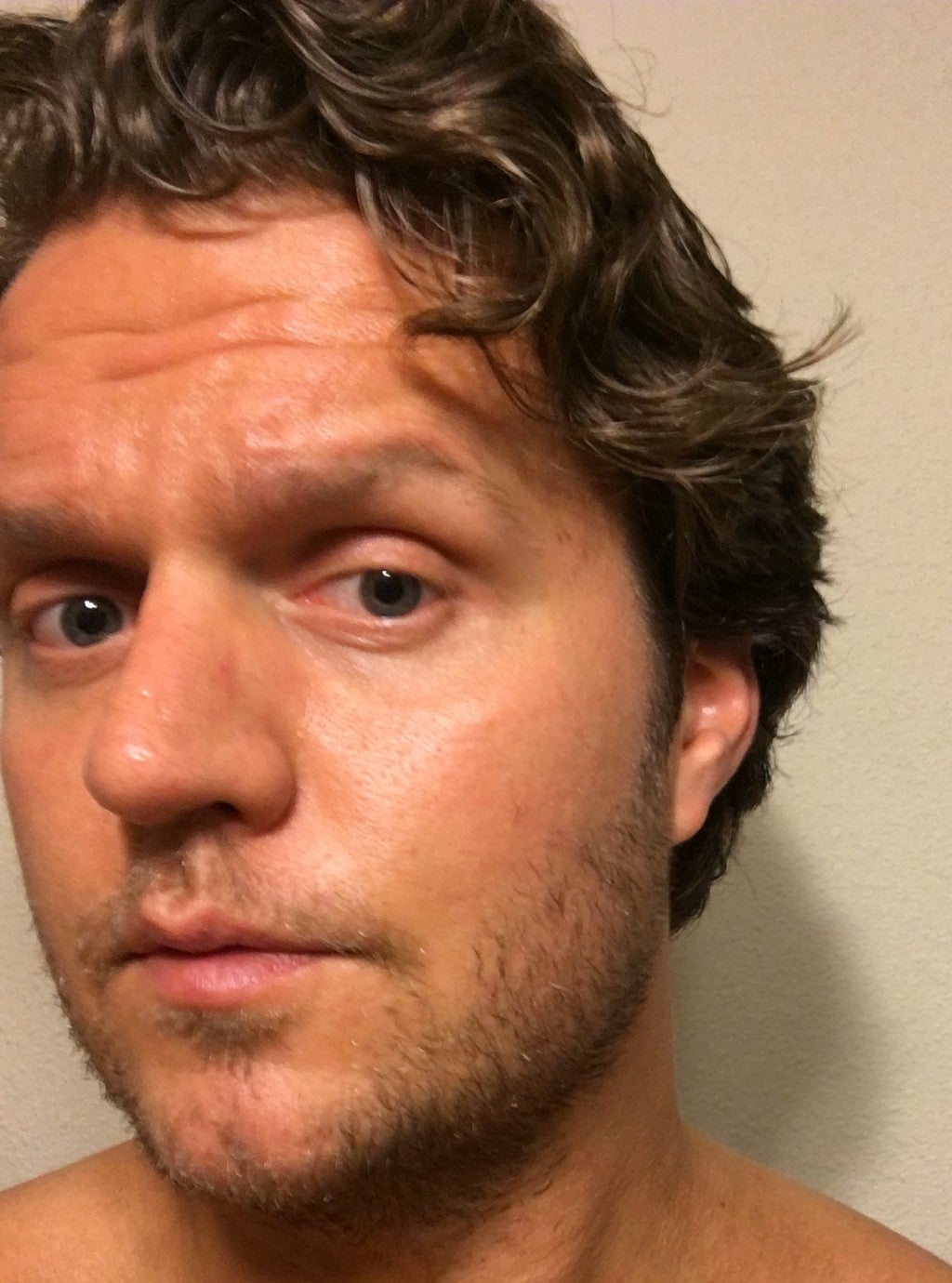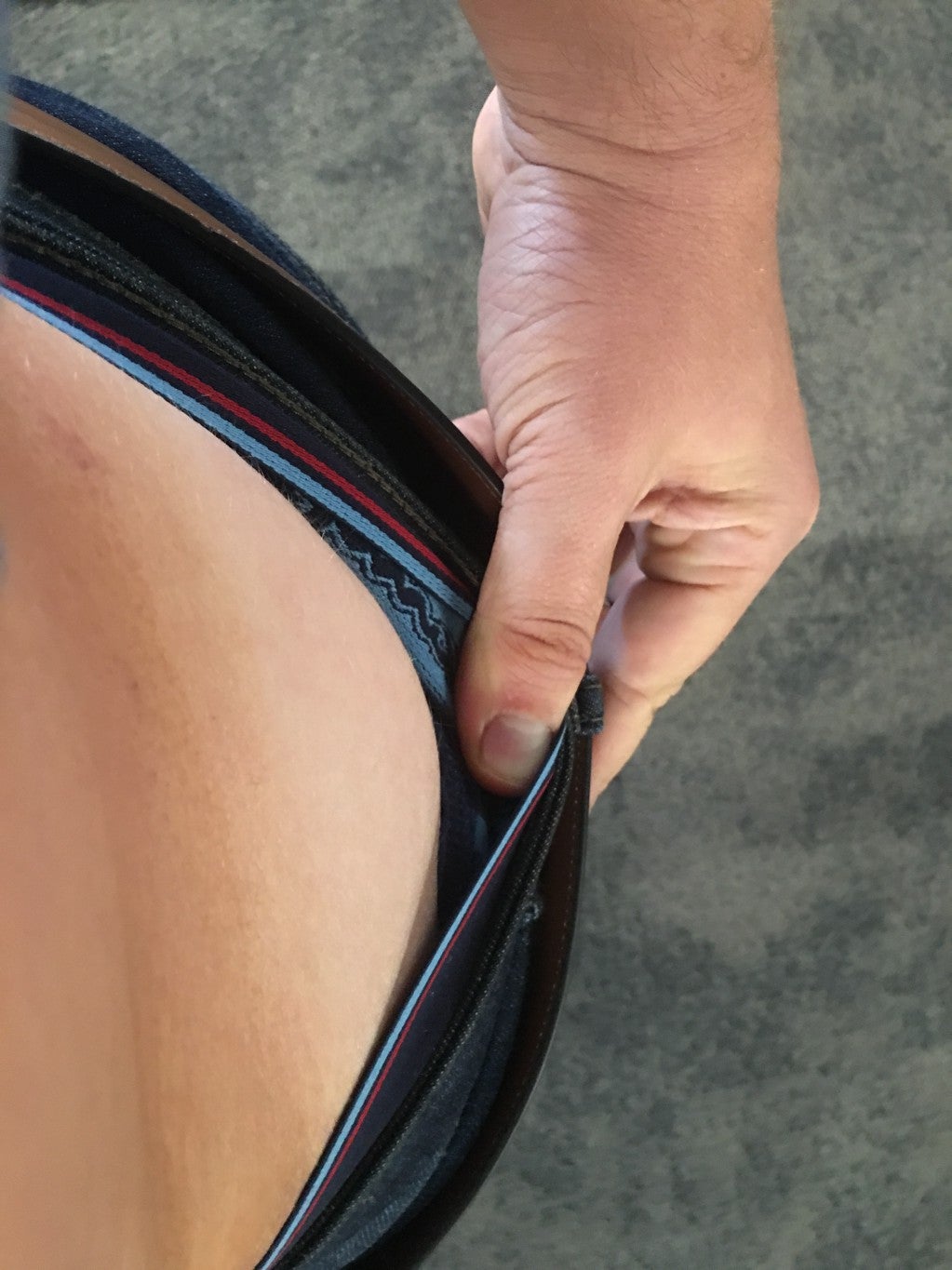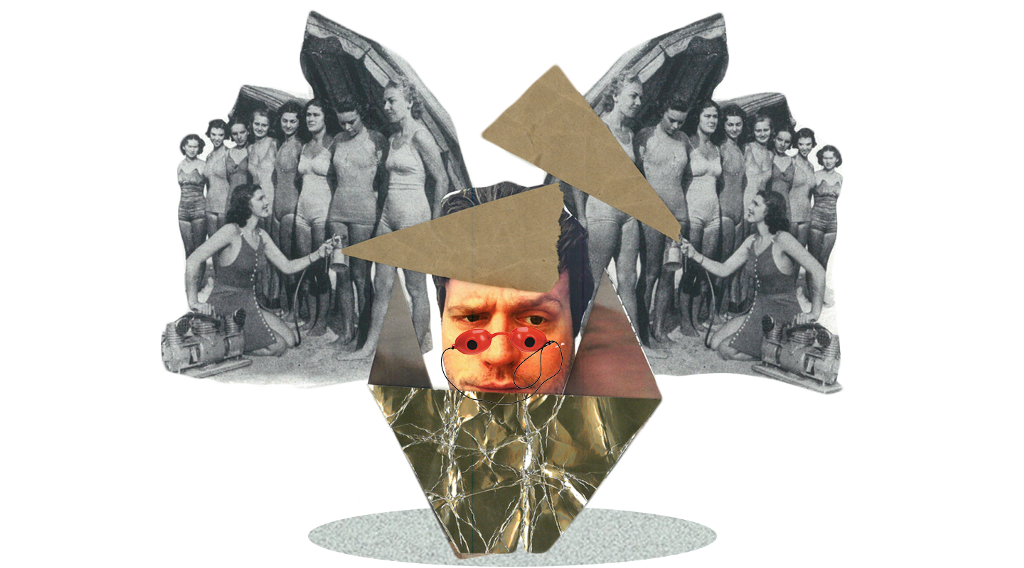I’m standing in front of an industrial-grade exhaust fan in nothing but boxer-briefs, making a series of Vitruvian Man poses while Kimmy, the kind-hearted soul at Chocolate Sun spray tan shop in Santa Monica, sprays me down with a coat of all-natural, organic, caramel-colored liquid. “The liquid is derived of sugar beets and bonds with the dead skin cells on your body!” she tells me in her perpetually cheery voice.
The official name of the liquid I’m currently being misted with is Weekend at the Beach, a blend meant to make me look as though I’ve spent, you guessed it, a weekend at the beach. Kimmy is applying it with a chrome spray gun typically used for professional paint jobs. And so, I feel like a classic lowrider receiving a fresh coat.
If this seems like an extraordinary length to go just to make it seem like I laid out on the beach for a few days without actually doing so — especially when the beach is literally two blocks away — consider these twin postulates:
- Our culture hates pale people, and places a premium on being tan.
- There’s no way to get a UV ray-induced tan without increasing your chances of skin cancer.
This poses quite the pickle for the modern image-conscious male. On one hand, society considers you a sickly neckbeard if you don’t have a sunkissed glow about you. On the other, obtaining one, either by tanning bed or direct sun exposure, actively kills you.
The only solution to this dilemma, then, is a tan that’s entirely UV-free. In that vein, I set out to test four different ones.
Tan #1 — The Natural Solution: Beta-Carotene Supplements
“Our culture has a tanning epidemic,” Deborah Sarnoff, dermatologist and president of the Skin Cancer Foundation, tells me from her cosmetic dermatology practice in Long Island.
As a skin-cancer surgeon, Sarnoff has the depressing task of seeing the effects of this epidemic up close, and she says the epidemic has reached full-blown “crisis” levels in Western countries, where the problem is most pronounced (but more on that later). Her assertion is born out by the data: Skin cancer is by far the most common form of cancer in the U.S., according to the CDC, afflicting more Americans than all other forms of cancer combined. And the trendline suggests that things are only getting worse — in the past decade, the number of new melanoma cases has increased by 53 percent.
Pretty bleak! As such, I initially seek out a tanning solution that dovetails with our culture’s current health craze, and stumble upon this piece of questionable science reporting from The Huffington Post that claims a person can increase their tan purely through diet. Apparently consuming foods rich in beta-carotenes (e.g., carrots, tomatoes, sweet potatoes, kale and spinach) adds a natural pigmentation to your skin. And increased pigmentation increases your perceived attractiveness, according to this 2011 study by British researchers.
Eating more vegetables sounded like a chore, though, so instead, I opt for the lazy route and buy a beta-carotene supplement from Amazon. Now, I’m a junk-science skeptic, but my face definitely has a splash of color after a few days of ingesting these little suckers. And I can’t chalk it up to getting more sun, because L.A. has been very overcast lately. (“May Gray,” it’s a thing.)
As proof, here’s a photo of me (left) with a tinge of orange in my face at a wedding last weekend, where someone even remarked on my “light tan” (sick).
Tan #2 — The Beauty Magazine Pick: St. Tropez Tanning Mousse
As a kid, I remember reading in Esquire that you should go to a tanning salon before attending an important party. Your tan, Esquire argued, will give people the impression that you just got back from somewhere “interesting.” Esquire was essentially telling me to concoct a story about a fake vacation I didn’t actually attend, just to impress strangers. That’s sociopathic.
More than a decade later, though, the beauty-magazine-industrial complex is still pushing the tan standard on us — albeit now via UV-less means. I peruse GQ, Vanity Fair and Vogue and find that they all recommend the same at-home self-tanner: St. Tropez Gradual Tan Pre Shower Mousse. This product is supposed to be ideal for urban yuppies in that it provides a “subtle, natural looking, sun-kissed glow” and doesn’t leave you looking like an Oompa Loompa. It’s also convenient — you rub the mousse into your skin, let it sit for a minute and then take your daily shower.
To test the mousse, I decide to apply it to the palest part of my body — my thigh. For the sake of science, I only put it on one thigh (my left), leaving my right unkissed by that subtle, natural looking glow.
It’s definitely as subtle as promised. So subtle, in fact, that there’s no discernible difference between my thighs after five straight days of application. My left thigh is still as blindingly white as my right one.
Tan #3 — The Cutting-Edge Option: Chocolate Sun
The fucked up thing about all this is there’s absolutely zero empirical evidence that being tan is actually healthier or more attractive. “There’s nothing inherently healthy or sexy about [being tan] at all,” Sarnoff says. “There’s no universal standard of beauty. They’re all 100 percent constructed.”
It’s telling that the aforementioned study, in which participants rated tan faces as more attractive, took place in the U.K., because it’s only Western countries that place a social premium on being tan, Sarnoff says. (As part of her skin-cancer awareness advocacy, Sarnoff functions as an expert on the anthropological history of complexion and beauty standards.) And even in the West it’s a relatively new construct. Back in the 19th century, when the U.S. was still an agrarian economy, being tan was considered low class and undignified. It meant you spent your days toiling in the fields, underneath the blazing sun like some plebeian. (Hence the lasting negative association with farmer’s tan.) Being pale, however, was a sign of style and grace. It brought to mind Victorian aristocracy who made up their faces to look like porcelain dolls.
That flipped in the 1920s, though, for two reasons:
- The Industrial Revolution brought laborers inside, away from the sun. Conversely, having enough leisure time to lay out and get a tan became a mark of wealth and success.
- Famed French fashion designer Coco Chanel accidentally got too much sun in 1923 on a cruise to Cannes, making the tan look chic. The emerging middle class aspired to sun-baked vacations and tans of their own.
“Everyone wants to be the opposite of who they are,” Sarnoff explains. “People with brown eyes want blue ones. Brunettes want to be blonde. Women with small breasts want big fake breasts, and women with large breasts want a breast reduction. It’s just human nature. We’re just not happy with who we are.”
And I, at least for the purposes here, want my pasty Midwestern hue to be much more golden. All of which brings me back to Kimmy and Chocolate Sun. I discover them by way of Goop, and despite my complete and utter contempt for the pretentious, New Age, hilariously overpriced wellness economy, I have a delightful experience at Chocolate Sun. (Also, Chocolate Sun isn’t all that overpriced at $52 — relatively speaking at least.) From the faux rustic, Restoration Hardware decor, to the exceedingly buoyant Kimmy, to getting blasted by a spray gun normally reserved for painting a jet, the entire thing is enjoyable.
And the tan itself is great. A coworker even comments on my golden brown glow the moment I return to the office.

Here, too, is a look at my tan line the following morning, after taking a shower and a full night’s sleep.

Tan #4 — The Nuclear Option: Bodybuilder Tanning Cream
There’s one area where tanning serves more than an aesthetic purpose and has legitimate functional value: Bodybuilding.
Applying a deep tan accentuates a bodybuilder’s contours and muscle cleavage, making them appear even more cut. As such, the bodybuilding industry produces some serious self-tanners — shades so dark, intense and shiny you’d never use them outside of a bodybuilding competition. Take, for instance, the fella in the following video, who looks as though he were dipped in bronze:
The bodybuilder tanning mousse I try is called Dark As… Professional Contest Tan, and is explicitly made for competitive bodybuilders. I purchase it from this U.K.-based website, and it arrives in a hand-wrapped, cylindrical package that immediately makes me think pipe bomb. Not the association you want when you’re just looking for a little color.
I can’t in good conscience recommend that anyone use this stuff in earnest, as the color is so dark that it borders on problematic. Take, for instance, the contrast between this bodybuilder’s face and the rest of his body:
Sarnoff confirms that a tan helps accentuates muscle cuts and striations, which would be fine in-and-of-itself. The problem is, she says, is this contributes to the idea that a tan can mask other beauty problems such as cellulite and varicose veins, and reinforces the larger, destructive tan concept of beauty.
It’s ability to make me look swole or not, I put the bodybuilding mousse on my skin for a total of five seconds before wiping it off in an absolute panic. I’m not trying to inhabit the world looking like a sentient chocolate bar.
The Final Verdict: Color Me Less Than Impressed
Chocolate Sun is by far the most effective tanning solution I tested. I never thought a spray tan would appeal to me, but honestly, I’d go to Chocolate Sun again. Overall, though, the entire sunless-tanning experiment leaves me cold (nailed it, thank you). If for no other reason than our complexion complex is bullshit and completely unreasonable.
How unreasonable?
Sarnoff says that the social value of a tan is so great that telling people tanning causes cancer does little in the way of preventing them from tanning. Instead, the only effective strategy is to fight superficiality on its own terms. “If you tell young people tanning is going to make them age more quickly, and give them sun spots, they actually listen,” Sarnoff explains. “That has more resonance, because young people don’t think about mortality.”
